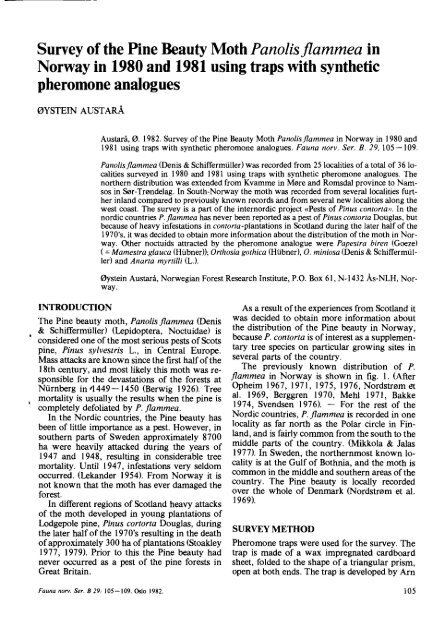o .eg an Jo of En1tomol0lD' - Norsk entomologisk forening
o .eg an Jo of En1tomol0lD' - Norsk entomologisk forening
o .eg an Jo of En1tomol0lD' - Norsk entomologisk forening
- No tags were found...
You also want an ePaper? Increase the reach of your titles
YUMPU automatically turns print PDFs into web optimized ePapers that Google loves.
Survey <strong>of</strong> the Pine Beauty Moth P<strong>an</strong>olis jlammea in<br />
Norway in 1980 <strong>an</strong>d 1981 using traps with synthetic<br />
pheromone <strong>an</strong>alogues<br />
0YSTEIN AUSTARA<br />
INTRODUCfION<br />
Austara, 0. 1982. Survey <strong>of</strong> the Pine Beauty Moth P<strong>an</strong>olisjlammea in Norway in 1980 <strong>an</strong>d<br />
1981 using traps with synthetic pheromone <strong>an</strong>alogues. Fauna norv. Ser. B. 29, 105-109.<br />
P<strong>an</strong>olisjlammea (Denis & Schiffermuller) was recorded from 25 localities <strong>of</strong> a total <strong>of</strong> 36 localities<br />
surveyed in 1980 <strong>an</strong>d 1981 using traps with synthetic pheromone <strong>an</strong>alogues. The<br />
northern distribution was extended from Kvamme in M0re <strong>an</strong>d Romsdal province to Namsos<br />
in S0f-Tf0ndelag. In South-Norway the moth was recorded from several localities further<br />
inl<strong>an</strong>d compared to previously known records <strong>an</strong>d from several new localities along the<br />
west coast. The survey is a part <strong>of</strong> the internordic project «Pests <strong>of</strong> Pinus contorta)). In the<br />
nordic countries P.jlammea has never been reported as a pest <strong>of</strong> Pinus contorta Douglas, but<br />
because <strong>of</strong> heavy infestations in contorta-pl<strong>an</strong>tations in Scotl<strong>an</strong>d during the later half <strong>of</strong> the<br />
1970's. it was decided to obtain more information about the distribution <strong>of</strong> the moth in Norway.<br />
Other noctuids attracted by the pheromone <strong>an</strong>alogue were Papestra biren (Goeze)<br />
(= Mamestra glauca (Hubner)); Orthosia gothica (Hubner), O. miniosa (Denis & Schiffermuller)<br />
<strong>an</strong>d Anarta myrtilli (L.).<br />
0ystein Austara, Norw<strong>eg</strong>i<strong>an</strong> Forest Research Institute, p.a. Box 61, N-1432 As-NLH, Norway.<br />
The Pine beauty moth, P<strong>an</strong>olis jlammea (Denis<br />
& Schiffermiiller) (Lepidoptera, Noctuidae) is<br />
considered one <strong>of</strong> the most serious pests <strong>of</strong> Scots<br />
pine, Pinus sylvestris L., in Central Europe.<br />
Mass attacks are known since the fIrst half <strong>of</strong>the<br />
18th century, <strong>an</strong>d most likely this moth was re<br />
sponsible for the devastations <strong>of</strong> the forests at<br />
Niirnberg in '1449-1450 (Berwig 1926). Tree<br />
• mortality is usually the results when the pine is<br />
completely defoliated by P. jlammea.<br />
In the Nordic countries, the Pine beauty has<br />
been <strong>of</strong> little import<strong>an</strong>ce as a pest. However, in<br />
southern parts <strong>of</strong> Sweden approximately 8700<br />
ha were heavily attacked during the years <strong>of</strong><br />
1947 <strong>an</strong>d 1948, resulting in considerable tree<br />
mortality. Until 1947, infestations very seldom<br />
occurred. (Lek<strong>an</strong>der 1954). From Norway it is<br />
not known that the moth has ever damaged the<br />
forest.<br />
In different r<strong>eg</strong>ions <strong>of</strong> Scotl<strong>an</strong>d heavy attacks<br />
<strong>of</strong> the moth developed in young pl<strong>an</strong>tations <strong>of</strong><br />
Lodgepole pine, Pinus cortorta Douglas, during<br />
As a result <strong>of</strong>the experiences from Scotl<strong>an</strong>d it<br />
was decided to obtain more information about<br />
the distribution <strong>of</strong> the Pine beauty in Norway,<br />
because P. contorta is <strong>of</strong> interest as a supplemen·<br />
tary tree species on particular growing sites in<br />
several parts <strong>of</strong> the country.<br />
The previously known distribution <strong>of</strong> P.<br />
jlammea in Norway is shown in fIg. I. (After<br />
Opheim 1967, 1971, 1975, 1976, Nordstr0m et<br />
al. 1969, Berggren 1970, Mehl 1971, Bakke<br />
1974, Svendsen 1976). - For the rest <strong>of</strong> the<br />
Nordic countries, P. jlammea is recorded in one<br />
locality as far north as the Polar circle in Fin<br />
l<strong>an</strong>d, <strong>an</strong>d is fairly common from the south to the<br />
middle parts <strong>of</strong> the country. (Mikkola & Jalas<br />
1977). In Sweden, the northernmost known locality<br />
is at the Gulf <strong>of</strong> Bothnia, <strong>an</strong>d the moth is<br />
common in the middle <strong>an</strong>d southern areas <strong>of</strong>the<br />
country. The Pine beauty is locally recorded<br />
over the whole <strong>of</strong> Denmark (Nordstr0m et al.<br />
1969).<br />
the later half <strong>of</strong> the 1970's resulting in the death<br />
SURVEY METHOD<br />
<strong>of</strong>approximately 300 ha <strong>of</strong> pl<strong>an</strong>tations (Stoakley Pheromone traps were used for the survey. The<br />
1977, 1979). Prior to this the Pine beauty had trap is made <strong>of</strong> a wax impr<strong>eg</strong>nated cardboard<br />
never occurred as a pest <strong>of</strong> the pine forests in sheet, folded to the shape <strong>of</strong> a tri<strong>an</strong>gular prism,<br />
Great Britain.<br />
open at both ends. The trap is developed by Arn<br />
Fauna norv. Ser. B 29, 105-109. Oslo 1982. 105

















